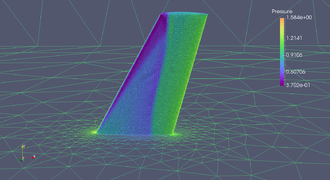Difference between revisions of "CFD Workflow"
m |
|||
| (5 intermediate revisions by 2 users not shown) | |||
| Line 18: | Line 18: | ||
==[[Solidworks]]== | ==[[Solidworks]]== | ||
| − | SSI's computer aided design program of choice since it is used in industry and is fairly easy to learn (and free for students). SSCP uses a lot of surfacing in order to get the complex geometries that they require. Most of our rockets will not require incredibly organic shapes (aside from a nose cone) so no need to get fancy. Any design (part, assembly, assembly of assemblies, etc) can be meshed with Pointwise. [ | + | SSI's computer aided design program of choice since it is used in industry and is fairly easy to learn (and free for students). SSCP uses a lot of surfacing in order to get the complex geometries that they require. Most of our rockets will not require incredibly organic shapes (aside from a nose cone) so no need to get fancy. Any design (part, assembly, assembly of assemblies, etc) can be meshed with Pointwise. [http://www.solidworks.com/ Link to site]. |
| − | |||
| − | |||
==[[Pointwise]]== | ==[[Pointwise]]== | ||
| Line 30: | Line 28: | ||
==[http://www.paraview.org/ Paraview]== | ==[http://www.paraview.org/ Paraview]== | ||
Open source visualizer which is optimized for very large datasets. A complex but also well-documented tool which will be SSI's visualizer of choice. | Open source visualizer which is optimized for very large datasets. A complex but also well-documented tool which will be SSI's visualizer of choice. | ||
| + | [http://www.paraview.org/paraview-guide/ Link to user guide]. | ||
| + | |||
| + | =Extra Resources= | ||
| + | [http://www.cfd-online.com/Links/onlinedocs.html CFD Online is awesome. Here is a link to their online doc resources] | ||
[[Category:Rockets]] | [[Category:Rockets]] | ||
| + | [[Category:CFD]] | ||
| + | [[Category: Rockets Guides]] | ||
Latest revision as of 14:52, 15 September 2017
Ian is currently working on creating a workflow for the Rockets team to get a better qualitative aerodynamic understanding of interesting geometries on rocket bodies. Click through a particular piece of the workflow to get help with installation, running, and particular SSI use cases.
The Big Picture
There are are four pieces to a successful computation fluid dynamics simulation:
- Modeling - Solidworks
- Meshing - Pointwise
- Solving - SU2
- Visualization - Paraview
The most difficult part of the process so far has been finding a workflow in which all the pieces fit together. For instance, Pointwise is one of the few meshers that takes Solidworks files in directly. If no program could, we would have to go through many formats until we finally arrived at the one we wanted (which would be inconvenient, computationally and temporally expensive). SU2 outputs Paraview's native input format, which is great, since SU2 and Paraview are both open-source (and thankfully free).
Special Thanks
Credit to the Stanford Solar Car Project (SSCP) for giving us hints as to how they set up their own CFD workflow. Also big thanks to Juan Alonso for helping us set up SU2 on Stanford's corn machine.
Solidworks
SSI's computer aided design program of choice since it is used in industry and is fairly easy to learn (and free for students). SSCP uses a lot of surfacing in order to get the complex geometries that they require. Most of our rockets will not require incredibly organic shapes (aside from a nose cone) so no need to get fancy. Any design (part, assembly, assembly of assemblies, etc) can be meshed with Pointwise. Link to site.
Pointwise
Currently on their way to becoming a sponsor of SSI, Pointwise accepts Solidworks files and meshes them for you. Obviously, this part is extremely important in identifying the interesting geometries. (I haven't worked with Pointwise very much yet, so more on this to come). Link to site.
SU2
Stanford developed, open source numerical flow solver. Written primarily in C++, the solver can easily extended due to its object-oriented programming and has fantastically written documentation. This will be SSI's solver of choice for the foreseeable future. Link to site.
Paraview
Open source visualizer which is optimized for very large datasets. A complex but also well-documented tool which will be SSI's visualizer of choice. Link to user guide.
Extra Resources
CFD Online is awesome. Here is a link to their online doc resources
